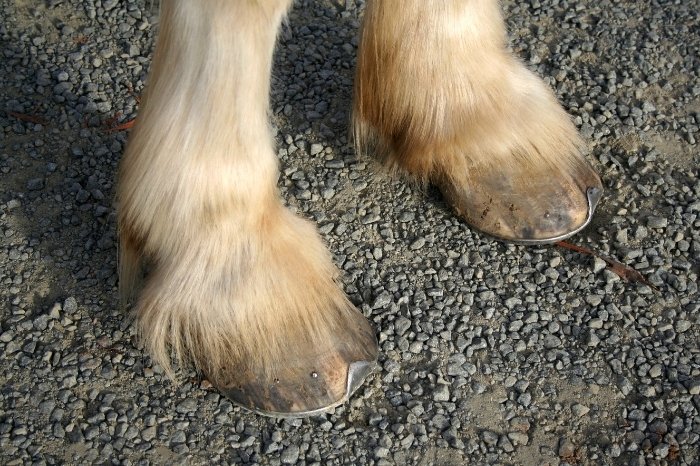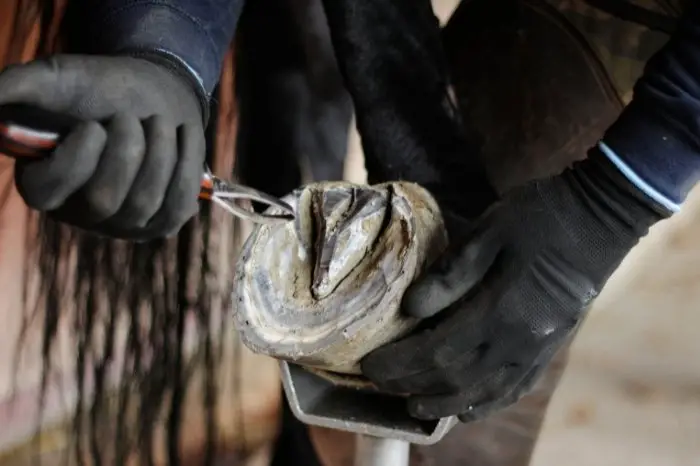Last Updated on October 6, 2022
Hoof diseases in horses are unfortunately very common and can be a difficult problem to solve. Understanding the most common hoof diseases in horses can help you to spot these problems early, halting them in their tracks. Let’s take a look at the most troublesome hoof diseases in horses, and help get your horse back on four feet again!
Common Hoof Diseases In Horses
Hoof diseases in horses are one of the most common problems that a horse owner or carer will come across. In fact, problems with the hooves are so prevalent that it is more likely to come across a horse with hoof disease than one without!
The most common hoof disease found in horses is thrush, an infection affecting the softer tissues of the hoof. After this, other disorders of the hoof include hoof wall cracks, bruising, growth rings, laminitis, and white line disease.

Hoof problems can be causes by mechanical or conformational problems, where the foot is imbalanced and hits the ground unevenly. They can also be caused by bacterial or fungal infections, or systemic disease such as malnutrition or obesity.
Not all of these hoof diseases in horses cause lameness, and they may only be identified when your farrier trims the hooves. However, if left untreated, they can cause serious long-term problems, so it is important to be able to identify the early signs of common hoof diseases in horses.
You Might Want to Read these Related Articles:
Common Horse Hoof Frog Problems
The most prevalent problem affecting the frog is thrush, a deep-seated infection of either bacterial or fungal origin. This occurs when the horse’s hoof is exposed to moist conditions for prolonged periods of time, such as in wet, soiled bedding or muddy grazing land.
Thrush is easy to identify as the smell is foul and unmistakable, particularly if the hooves have not been cleaned out regularly. There will be a black discharge around the clefts of the frog, and the horse may flinch when these areas are pressed.

If not treated quickly, thrush can be very problematic and lead to long-term hoof problems. The horse must be moved to a dry area and the hooves picked out regularly to remove dirt and debris. Your veterinarian will be able to advise you on the best treatments for thrush, which may include paring away damaged tissue and regular application of disinfectants.
Other problems such as hoof wall cracks, bruising, growth rings, laminitis, and white line disease should not be ignored, as they can cause long-term structural changes to the hoof wall.
Take Out Time to Also Read:
- Incubation Period Of Strangles In Horses – And Symptoms
- How To Properly Groom A Horse – Step-by-step Guide!
Horse Hoof Peeling At Coronary Band – Causes And Treatments
The coronary band is the line of tissue that lies between the lower part of the horse’s limb and the solid hoof wall. The importance of the coronary band is often overlooked, but it is a vital part of the anatomy and any abnormalities can result in complex hoof problems.
Coronary band tissue is the site of hoof growth – the same as the cuticle from which human fingernails grow. Any damage or restricted blood flow to the coronary band will result in poor or abnormal hoof tissue.
A healthy coronary band will be smooth and dry, with the overlying hair flat. If the coronary band is peeling or flaking, this is a sign of poor health and may result in abnormalities of the hoof wall.
There are many diseases that can affect the coronary tissue, or flaking may be a sign of systemic disease or ill health. It is impossible to determine the cause of flaking coronary tissue without veterinary investigation, which may involve a biopsy of the affected tissue.
Once your veterinarian has been able to reach a conclusive diagnosis, you will be able to discuss a comprehensive treatment plan. It is important not to ignore problems that affect the coronary band of your horse, as the long-term effects to the hoof wall can last for many months.
How To Help Unhealthy Horse Hooves
Have you ever heard the saying ‘no foot, no horse’? The hoof of a horse is one of the most vital and hard-working structures of the body – it supports the weight of the horse, and must withstand incredible levels of pressure as the horse moves. As the owner or carer of a horse, one of the most vital things you can do is ensure your horse undergoes regular hoof care.
Unhealthy horse hooves must be treated using a holistic care plan, that takes all the other body systems of the horse into account. The reason for this is that in order to build strong and healthy hoof tissue, the horse itself must be healthy and in great condition. There is little point putting lotions and potions onto the hooves if the horse is unable to grow new, stronger hoof tissue.
The other key factor in helping unhealthy horse hooves is to identify any underlying problems and attempt to remedy them accordingly. This will normally involve both your farrier and your veterinarian, as they will work together to diagnose and treat any problems with your horse’s hooves. If any systemic or mechanical problems are not remedied, your horse’s hooves will continue to remain in poor condition.
Treatments for hoof problems in horses can include trimming away diseased tissue or hoof wall, or reinforcing weakened areas of the hoof. Remedial trimming or shoeing can be used to correct poor foot balance. Any underlying causes should also be treated, such as malnutrition or obesity.
Summary – Hoof Diseases In Horses
So, as we have learned, the most common hoof diseases in horses include thrush, hoof wall cracks, bruising, growth rings, laminitis, and white line disease. A peeling or flaking coronary band can be a sign of poor health and may result in abnormalities of the hoof wall. Hoof diseases in horses should not be ignored, as they can cause long-term structural changes to the hoof wall and irreversible lameness.
We’d love to hear your experiences and questions about hoof diseases in horses! Do you have a horse that frequently suffers from hoof problems no matter what you do? Or maybe you’ve come across an excellent way to prevent hoof diseases in horses? Leave a comment below and we’ll get back to you!

Kate Chalmers is a qualified veterinary nurse who has specialized in horse care for the vast majority of her career. She has been around horses since she was a child, starting out riding ponies and helping out at the local stables before going on to college to study Horse Care & Management. She has backed and trained many horses during her lifetime and competed in various equestrian sports at different levels.
After Kate qualified as a veterinary nurse, she provided nursing care to the patients of a large equine veterinary hospital for many years. She then went on to teach horse care and veterinary nursing at one of the top colleges in the country. This has led to an in-depth knowledge of the care needs of horses and their various medical ailments, as well as a life-long passion for educating horse owners on how to provide the best possible care for their four-legged friends.
Kate Chalmers BSc (Hons) CVN, Dip AVN (Equine) Dip HE CVN EVN VN A1 PGCE

